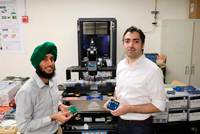 A solution for extending the battery life of wireless devices is being developed by a team at Stanford University.
A solution for extending the battery life of wireless devices is being developed by a team at Stanford University.
The idea is to attach a wake-up receiver to an electronic device, which turns on a device in response to incoming ultrasonic signals.
According to the team, by working at a smaller wavelength and switching from radio waves to ultrasound, the receiver is much smaller than similar wake-up receivers that respond to radio signals, while operating at extremely low power and with extended range.
"As technology advances, people use it for applications that you could never have thought of. The Internet and the cellphone are two great examples of that," said Angad Rekhi, a graduate student in the Arbabian lab at Stanford and one of the project researchers. "I'm excited to see how people will use wake-up receivers to enable the next generation of the IoT."
The receiver is constantly listening for a certain ultrasonic pattern, which the team claims requires only a very small amount power.
Assistant professor, Amin Arbabian, explained the challenges within the design. "Scaling down wake-up receivers in size and power consumption, while maintaining or extending range is a fundamental challenge. But this challenge is worth pursuing, because solving this problem can enable scalable networks of wake-up receivers working in our everyday environment."
The researchers used highly sensitive ultrasonic transducers from the Khuri-Yakub lab at Stanford, which they said converted analog sound input to electrical signals. This the researchers explained that this enabled them to miniaturise the wake-up receiver and reduce power consumption.
Through this, the team said they could design a system that was able to detect a wake-up signature with as little as 1 nanowatt of signal power.
This project was inspired by a previous Arbabian creation, known as the ant-sized radio. This nano chip was said to be able to send and receive signals over radio waves without a battery. The restriction here was that the chip needed to remain close to the transmitter.
By comparison, the team said, the ultrasound wake-up receiver requires a battery, but has a much greater range than the wirelessly powered devices, while still maintaining a long lifetime due to extremely low power draw.
The researchers hope that these two technologies could help to further IoT.
Author
Bethan Grylls
Source: www.newelectronics.co.uk
